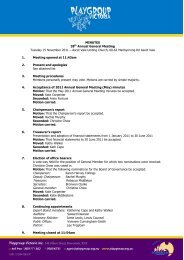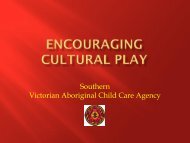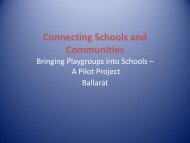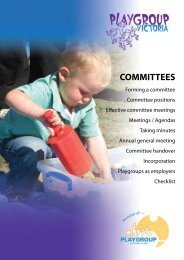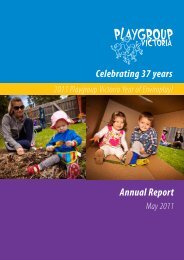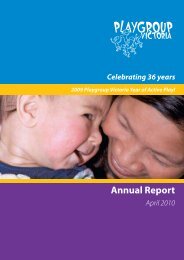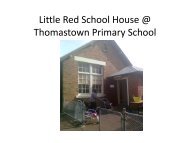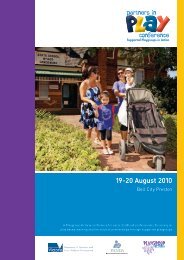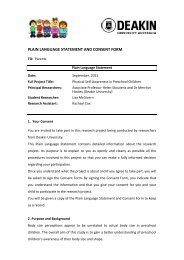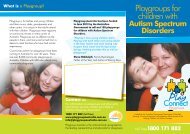All About Playgroup - Playgroup Victoria
All About Playgroup - Playgroup Victoria
All About Playgroup - Playgroup Victoria
- No tags were found...
Create successful ePaper yourself
Turn your PDF publications into a flip-book with our unique Google optimized e-Paper software.
LEARNING AND DEVELOPING THROUGHPLAYBaby playFrom the time a baby is born everything hesees, touches and does arouses curiosity anda desire to learn.<strong>Playgroup</strong>s support this learning. Babies love beingpart of the busyness at playgroup and are oftenmesmerised watching and interacting with otherchildren. New babies are best left safely in a pram orheld by their parent.Older babies will busily examine everything aroundthem, learning by seeing, touching, tasting, feeling andhearing. They explore and experiment to discover newinformation. New skills are mastered through practiseand repetition.At playgroup, you can help by understanding the waybabies learn and providing a variety of playexperiences.Create a safe place for babies to play in your playgrouproom out of the main traffic flow. Put a large rug on thefloor or grass outside and add some baby toys.Popular baby toys• Soft blocks or balls• Rattles• Activity centres• Safety mirrors• Mobiles• Commercial or homemade baby mats• Prams, cots or ‘A’ frame baby gyms• Soft toys• Bead frames• Books• Containers or plastic ware• <strong>All</strong> these toys in a box, bag or basket for olderbabies to unpack and packQuiet playPlay is not always busy; it can be restful and soothing.Quiet reflective play is as important to your child’swellbeing as times of social and physically active play.Give babies time to lie on their backs to stretch, kickand develop hand skills or on their tummy tostrengthen back, neck, shoulder and arm muscles andto practice head control.If a baby becomes unsettled at playgroup the parentcan share a book, sing lullabies or take the baby towhere children are playing.MusicGather a few babies and parents together and sing orchant simple nursery rhymes like, Humpty Dumpty. Addfinger movements as you sing Twinkle, Twinkle, Little Star,or put actions to Row, Row, Row your Boat. Play gameslike Peek–a–Boo or touching games such as Round andRound the Garden. Play different styles of music. Putshakers, rattles and musical toys with the baby toys.Babies are active learnersTheir toy play develops through the following stages:• watching objects• following moving objects with their eyes• reaching out• taking hold of an object• examining it with eyes and hands• squeezing and patting with hands• passing the toy from hand to hand• putting it to their mouth to explore it by sucking,biting or chewing• dropping it to watch it fall• banging toys together.It is not necessary to buy expensive toys. Put togethera container of safe colourful objects from around thehome. You could even try making things for babies toplay with.SafetyWhen offering toys to a baby avoid:• anything sharp or broken• anything smaller than a film canister• detachable or small parts like buttons and eyes• cords longer than 30cm• toxic paints or plastics.36 <strong>Playgroup</strong> Manual



